Le Mans hero Ron Flockhart's early days: a career takes off
The 1950s was a good time to start racing. Gordon Cruickshank speaks to a first-hand witness of a future Le Mans winner’s first steps. It was a career that would end in tragedy – but not on the track

Lost talent, or lost cause? The career of Ron Flockhart was a mixed one, and his early death left much of his potential unrealised
Bernard Cahier/Getty Images
“Ron Flockhart could have won anything if given the chance.” That’s the view of the Scottish driver’s business partner and close friend Hugh Langrishe, who at 96 still has clear memories of the times they spent together. Those 1950s were a time of private enterprise and privateer entries, when you could buy an old racing car and enter it in top-line events against existing stars, and be spotted by team owners. Further, the era of freelance drivers and one-off drives meant a healthy range of opportunities for a driver who showed a bit of spark. And when he had the right equipment Flockhart’s spark was high-voltage: two Le Mans victories don’t come easily. Yet his 13 grand prix starts yielded just one podium. Perhaps his name would be better remembered if he had achieved his parallel aim – to break the solo flight record from Sydney to London. But 58 years ago that would tragically end his life, when his Mustang P51D aircraft plunged into an Australian hillside. He was not yet 40.
Hugh Langrishe, an upright and dapper figure despite his years, has many photos of their adventures and when we met, pre-lockdown, he talks fondly of those times when Flockhart’s star was rising.
Tall, fair-haired and good-looking, Flockhart was born into a well-off family and went to Edinburgh’s prestigious Daniel Stewarts school. Confident and affable, he had the dashing air of a Hawthorn or Collins but was no playboy: with a war career behind him as a Royal Electrical and Mechanical Engineers (REME) captain, he combined a degree in engineering with an innate feel for machinery and an ability to give good feedback on a car. That made him a useful test driver.
Hugh and Ron met first while studying mechanical engineering in Edinburgh, or more specifically at the Rest and Be Thankful hillclimb. “He was driving his self-tuned MG TC, and Raymond Mays was impressed and suggested that he get single-seater experience.” Hugh says. “So for 1951 he got Vincent to build a Black Lightning V-twin and put it in a Joe Potts F3 chassis.”
That was a successful season, including winning the Formule Libre event at the Ulster Trophy. By now Hugh was Ron’s pit crew. “We couldn’t afford the boat fare for an extra vehicle, so John Watson’s father Marshall offered to tow three cars one behind the other from Belfast to the circuit. He set off at a smart 45mph – the guy at the back didn’t know what was happening!”
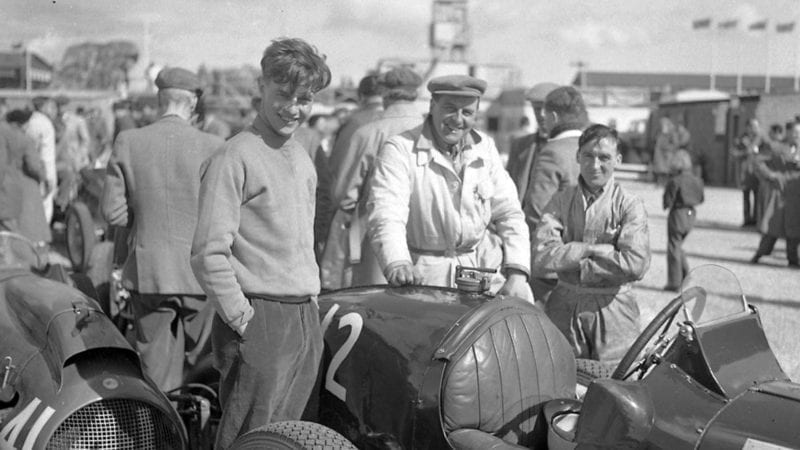
1953 was a pivotal year for Flockhart, with a string of successes with ERA R4D, seen here at Goodwood
Hugh Langrishe
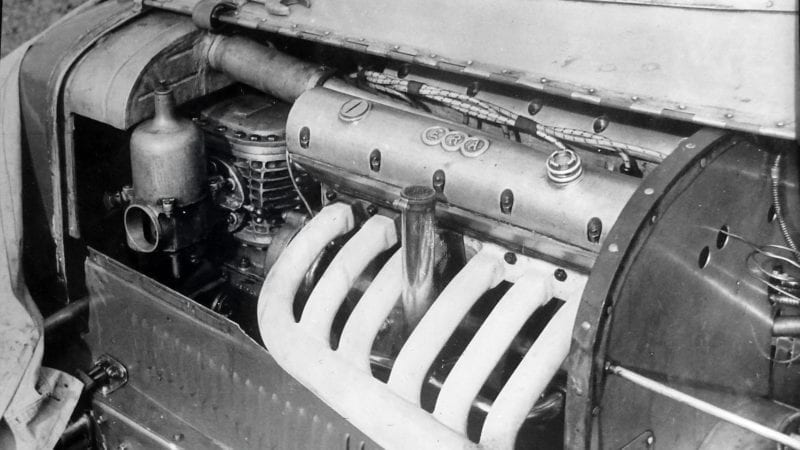
The engine of ERA R1A at Dundrod in 1952
Hugh Langrishe
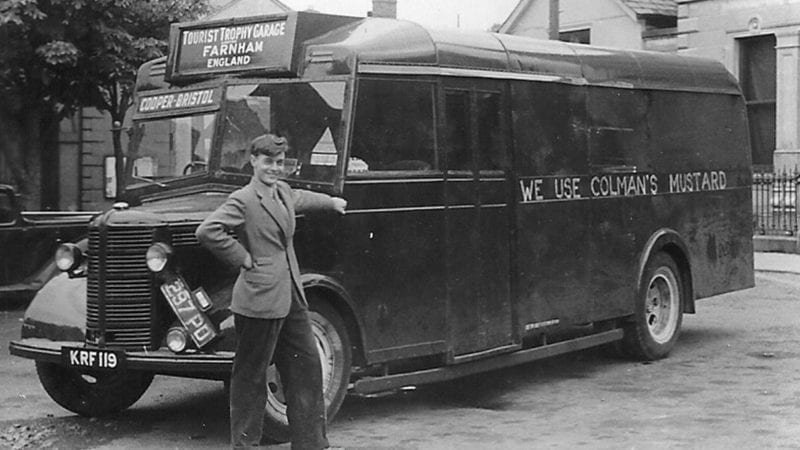
Ron after the Dundrod race with Mike Hawthorn’s team transporter
Hugh Langrishe
For the next year Flockhart bought ERA R1A from David Murray, with Alistair Birell. Their assault on the ’52 Ulster Trophy was pretty low-budget: “The car was craned onto the boat with all the tools and spares crammed in the cockpit,” recalls Hugh, “and Marshall Watson loaned us a Ford Pop.”
Practice brought a major problem: “The car stripped its back axle, but we found a replacement and swapped it overnight in the hotel garage. We rang the Clerk of the Course for a late entry, Ron warmed the car on the 10-mile drive to the circuit and he drove straight onto the grid.”
That grid had some serious firepower: BRMs for Fangio and Moss, Ferrari 375s for Taruffi and Rosier, and a Cooper-Bristol under Mike Hawthorn – tough opposition for a pre- war car. But (once the BRMs had inevitably vanished) the young Scot was soon running third. “We had no idea of the fuel consumption; I was ready to tip fuel in, scared stiff I’d set poor Ron in flames. Then he didn’t appear – he’d run out of fuel.”
However, this impressed Mays enough that he later sold Flockhart his successful R4D. As well as a good season through 1953 – eight wins including Goodwood, Charterhall and Snetterton – the upright ERA would cement a connection with the Bourne concern.
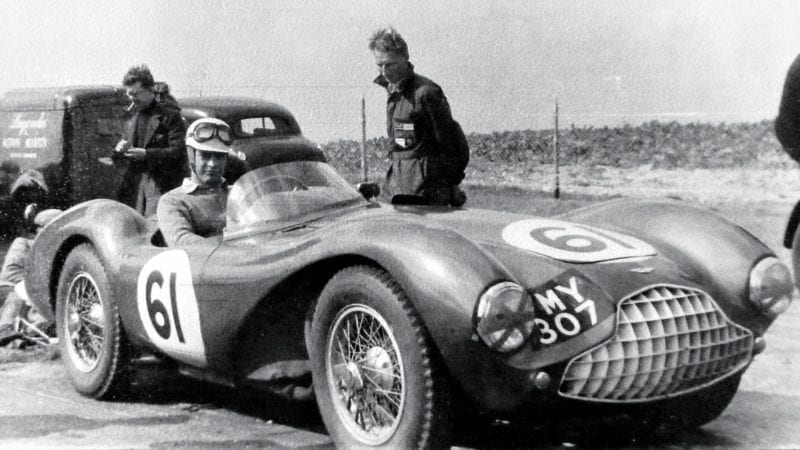
With his star on the rise, Flockhart found himself getting chances with other teams. He finished second at Snetterton in a works Aston Martin DB3S in 1953
High Langrishe
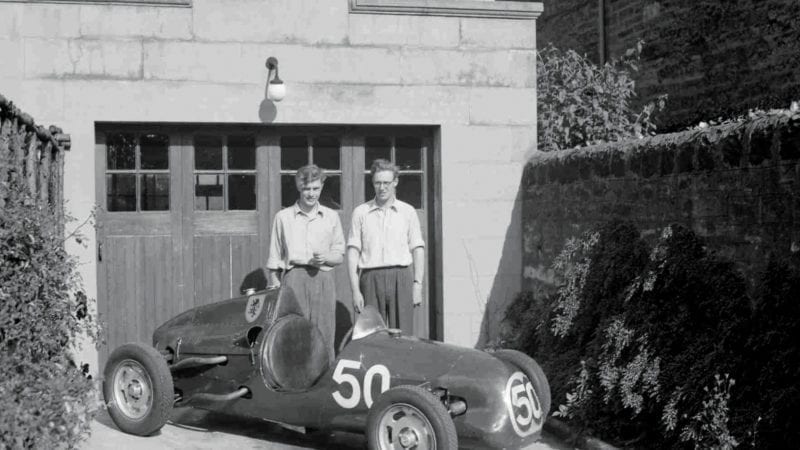
Ron and Hugh line up beside Ron’s Joe Potts F3 car at home in Edinburgh in 1951
High Langrishe
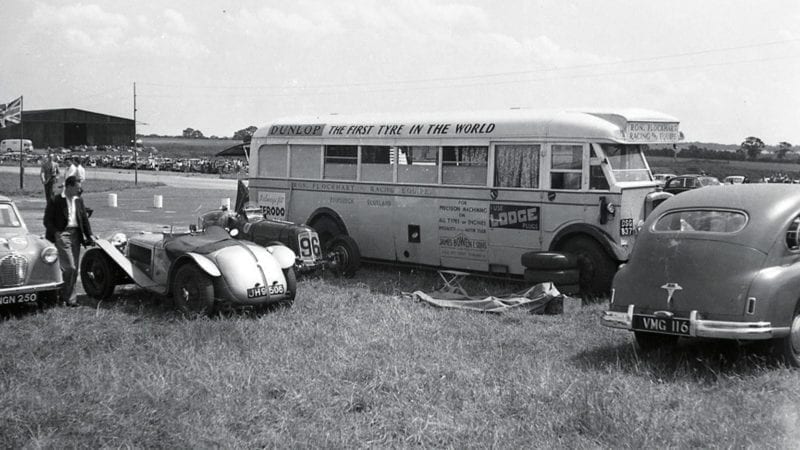
The R4D team setup at Snetterton in ’53
Hugh Langrishe
Through that 1953 season Ron and Hugh managed their part-time racing. “There were just the two of us at meets; we’d sleep in the field beside the car in our sleeping bags. Then Ron bought an Edinburgh Corporation bus and put a living cabin in front with two bunks and a gas ring.”
Ron was being noticed: at Snetterton he was invited to race a works Aston Martin DB3S, while at the British GP support race he placed fourth behind Farina, Fangio and Wharton. “If I’d been more alert I’d have given him the ‘Faster’ sign!” says Langrishe. “Then Rodney Clarke offered him a Connaught to drive. He and Roy Salvadori practiced it and Ron did the faster lap. He got on well with Clarke; remember, Ron was a meticulous engineer.”
But it was BRM who took the cheerful Scot on board as a tester and development driver for 1954; at the same time he resigned his job in a textile firm and took a sales post at a Wolverhampton car dealer, like BRM a part of Rubery Owen, and advertised R4D in Motor Sport – at £1500. He was now a quasi-works driver, waiting for his career to kick off. “But it wasn’t very satisfactory,” says Hugh. “There was no actual post of test driver, so he was imposed on Clarks and they weren’t keen. When a test was due Ray or Peter would ring up and Ron would trot off to Folkingham.”
“Of course racing was very much still an ‘old boy’ network,” says Hugh. “Collins, Hawthorn and the others, they all had businesses behind them. Moss was the only professional racing driver.”
Which left Flockhart free to drive that Connaught in non-championship races, including a third at Charterhall.
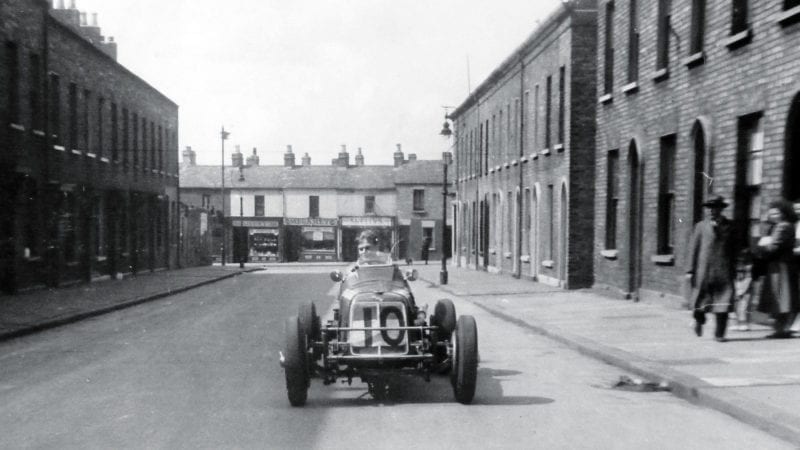
Ron driving R1A through Belfast to scrape onto the Dundrod grid in 1952
Hugh Langrishe
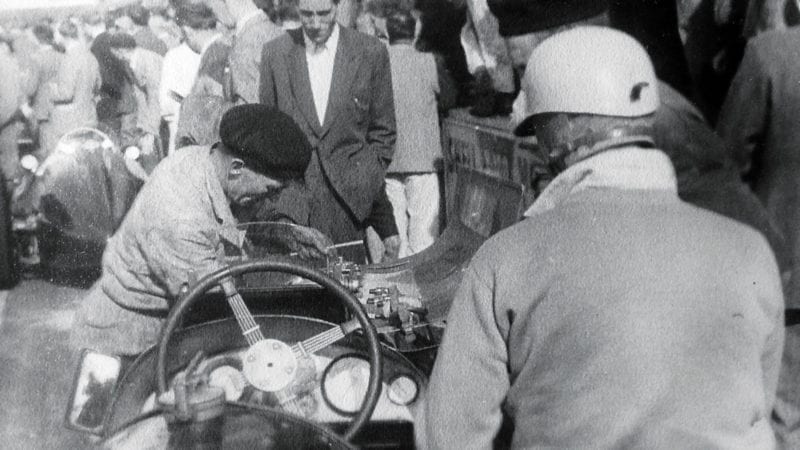
Team engineer ‘Wilkie’ tweaks R4D in 1953. His skills were often overstated…
Hugh Langrishe
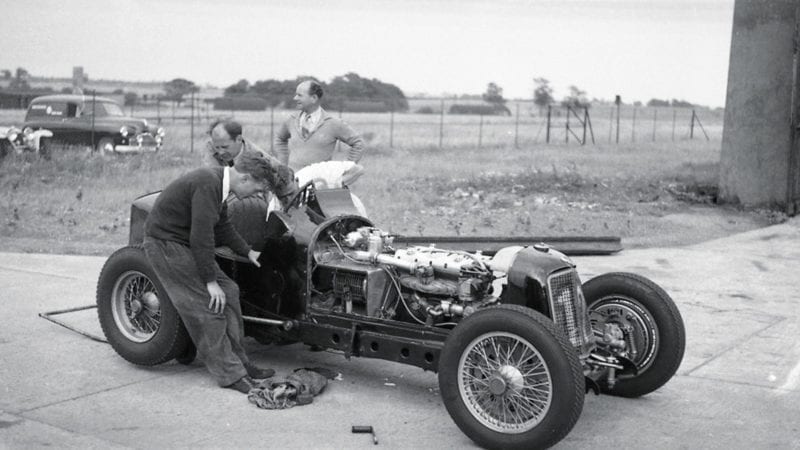
Mays, Ron, Alistair and Charlie Davy with R4D during a test at Folkingham, 1952
Hugh Langrishe
Through 1954 Flockhart put in many hours screaming around Folkingham aerodrome in the MkII V16, its centrifugal supercharger wailing to the Lincolnshire skies. Hugh remembers: “One evening about 7pm [José Froilán] González came to test it, and you could hear it all round the circuit. I never heard anything like it in my life. It still makes me emotional to think of it.”
Hugh got to know Mays well: “A nice chap but no organiser. Lots of work was sent out but came back late or wasn’t done. BRM was an extraordinary outfit; I had by now switched to factory management, and I found BRM chaotic. No-one was responsible for quality checking. Before Rubery Owen took it over, Mays admitted to me once ‘The trouble with operating as a trust is that with organisations and people doing things for you as a favour instead of for money, you can never get things done on time’.”
By now Langrishe was Flockhart’s intermediary. “One night I got a call about 11.30pm – ‘Do you know where Ron is?’ I was quite rude. Next day Ron asked me to be more polite to Ray.”
But Ron remained the bridesmaid at BRM, with minor successes in non-title races, now the V16’s only hunting ground, while in ’55, when Peter Collins was the favoured son, Ron placed second in the V16’s last front-line race. He helped develop the new Type 25 for the 21⁄2-litre formula, but was mostly denied a race in the stop-gap 250F Maserati the team ran, watching Ken Wharton or Peter Collins race instead.
“Ron was never given the chance, except once” says Hugh. “At Silverstone for the ’54 British GP Mays persuaded Owen to let Ron be a reserve to Prince Bira.” Suffering from malaria, the Siamese driver handed over the Maserati on lap 43, “but Ron got on the wet stuff and turned it over”. It was his grand prix debut. It would be 1956 before his next entry, when the engine failed. Thereafter he had races when a car was available but was seen more as a reliable back-up than a leader.
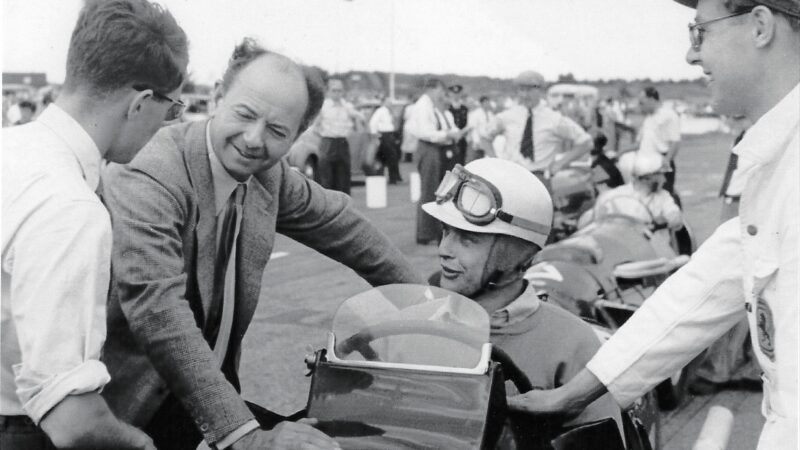
Raymond Mays (facing) encouraged Flockhart, selling him ERA R4D which brought eight wins in 1953. Langrishe on right
Hugh Langrishe
Still, Ron and Hugh did manage to attend one meeting abroad. “Ron decided we’d fly to Reims for the 1954 grand prix. We flew from Croydon in his Auster with no radio, no pilots’ maps and no airfield details. About 10 miles from Reims we spotted a big airfield and Ron landed, but we were surprised to see Sabre jets there. The French air force were furious… We finally found the civil aerodrome and took a taxi into town. There was no accommodation to be had, but we found Ray in the most expensive hotel and asked him for help. His boyfriend wasn’t there, though his picture was on the dressing table, so he said we could share his 6ft bed with him.”
Apropos, Doug Nye tells a tale he had from BRM’s Rivers Fletcher, that Flockhart couldn’t understand the furtive jokes about Mays until Rivers explained Mays’ sexuality to the naïve young Scot.
This was also the era of post-race driver excesses: “The morning after the race we woke to find a tiny car on the first-floor landing. There was a certain amount of dismay on the part of the hotel management.”
That race was also the first event for the long-awaited Mercedes team. “It took the wind out of everyone’s sails when this long convoy of grey trucks arrived in the main square at Reims,” recalls Hugh. “All the teams were garaged in town; you could hear the lovely noise of the engines being blipped, and then the mechanics drove the cars to the circuit. And they weren’t hanging about.”
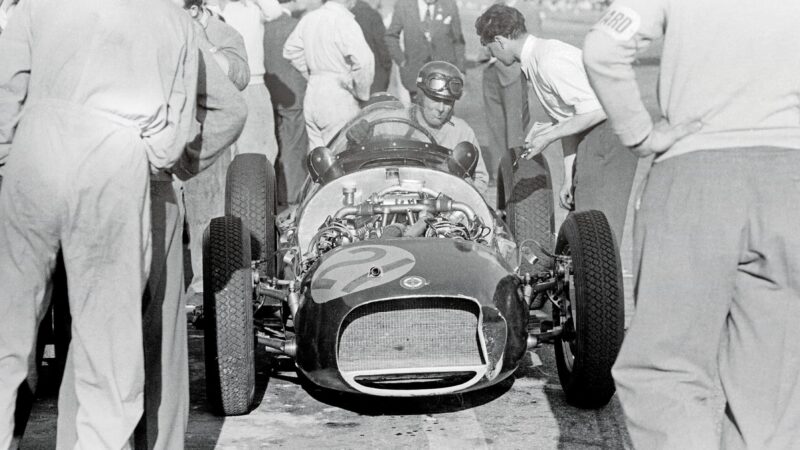
By 1954, outings with BRM were becoming scarce, Flockhart resigned to a handful of runs in the ERA V16 in Formule Libre
GP Library via Getty Images
Though the single-seater opportunities were few, Flockhart also had a gift for sports cars, especially endurance racing. It would lead to his greatest results, with Ecurie Ecosse at Le Mans. Team principal David Murray had previously tried to recruit Ron, “but he was very difficult to deal with,” Hugh remembers. “Just lack of money. People asked why Ron hadn’t driven for him; well, we knew what was going on.” Murray’s creative money management would later see him leave Britain hurriedly, but for 1956 Murray did a deal for Flockhart to share one of the metallic blue D-types with Ninian Sanderson. Langrishe says: “There was no contract, just a letter. I tried to get a contract out of Murray but he wouldn’t write one. Ron never knew when he was going to get any money.”
Those 1956 and ’57 races are an oft-told tale: against all expectations Flockhart and Sanderson’s Ecurie Ecosse car prevailed over the Astons, Ferraris and the works D-types. One year later sharing an ex-works long-nose D with Ivor Bueb, Flockhart again received the 24-hour laurels. “Our car had the 3.8 fuel injection system lent by Lucas, which was removed afterwards. And yes, it’s true that Jaguar kept the car as long as possible so that Wilkie [Wilkinson, Ecosse chief mechanic] couldn’t fiddle with it. We all thought he was good at his job, but it turned out he wasn’t.”
He shakes his head at the safety aspect now. “Cars were going past at 150mph and people were lined up along the edge of the track. We just didn’t realise…” he recalls. He himself was anxiously handling timing: “It’s very hard – peering through legs because the team manager is on the pit counter yelling at chaps down below, and you daren’t miss your car. Night-time is worse, but I could tell the Jags because they wouldn’t lift off into Dunlop. They were brave.”
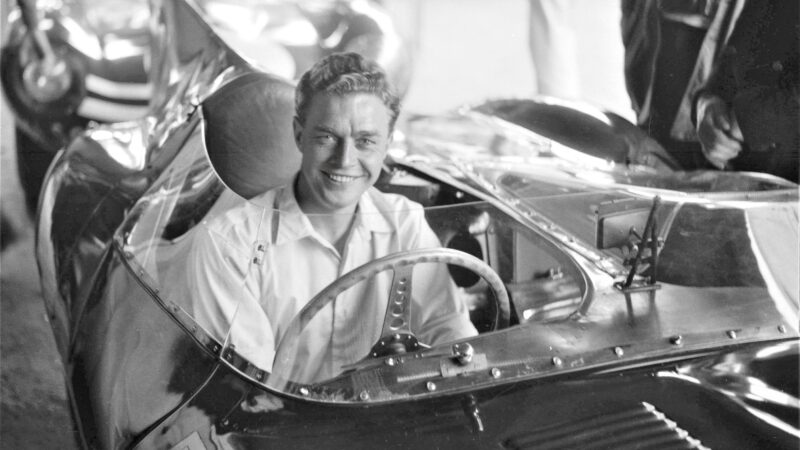
Flockhart’s greatest achievements came with the Ecurie Ecosse D-type, with back-to-back Le Mans victories
Hugh Langrishe
He remembers Ron’s first break in 1957: “He handled that long race very well. In the evening we both headed for the team caravan and met Johnny Lurani, who had earlier accommodated the Ecurie Ecosse team for the Mille Miglia. He said, ‘Now the grand prix is finished, the 24 Hours of Le Mans begins!’
Driving a D-type solo and with minimal recce time behind him, Flockhart had been up to seventh in that Mille Miglia until the fuel tank worked loose.
Only a few weeks later and he was on the winners’ podium at Le Mans. “And all these mature people were in floods of tears,” Hugh smiles.
Those 24-hour successes are well known. Not so what happened in 1958. Ron was due to contest that Le Mans race too, but the week before in practice for the Rouen 3Hr sports car race his Lotus XV crashed into an ambulance, seriously injuring him.
“A lot of people told him to give up, but he was very determined”
Hugh and his wife Pam, en route to La Sarthe, diverted to the hospital. “We were horrified with the place. There was no-one around; Ron said ‘For God’s sake get me out of here!’. So we got him dressed somehow; he could walk slowly, and we took him out without being challenged. Luckily we had his Austin A105 estate car; we laid him in the back and took him to Le Mans where one of Murray’s pals, an orthopaedic surgeon, said ‘For Christ’s sake, you’ve broken your back!’ So we set off home. We got a flight on Silver Cities airways and he was allowed to stay lying in the car while we flew. I drove him to the family home in Edinburgh but I was worried. His parents believed in all sorts of natural healing – when his sister caught pneumonia they got homeopaths instead of doctors and she died – and I was in fear of the same. But he went to hospital and made a full recovery. A lot of people told him to give up, but he was a very determined man.”
By 1958 Ron and Hugh were partners in Flockhart & Langrishe, a garage business they had co-founded in Ascot High Street, though it was mainly Hugh’s concern.
“Our company was not a dealership, it was a management company to run Ron’s enterprises,” says Hugh. “I put up most of the money; Ron wasn’t an active partner – he was away racing most of the time. I ran the firm, and it gave a meagre living.”
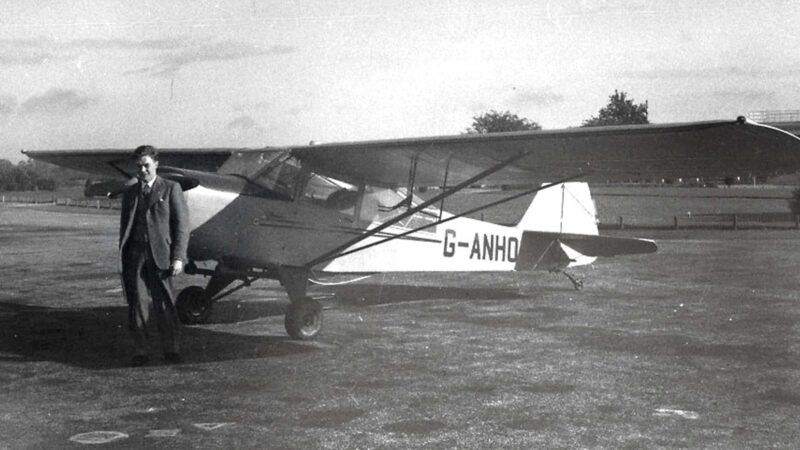
Flockhart with his Auster in 1956
Hugh Langrishe
From this point Hugh had less to do with Ron’s arrangements, though they remained close friends, so the inside stories fade. In truth, the stop-start career continued: Flockhart remained doggedly tied to BRM until 1959 with intermittent races now the 25 was coming good, bringing him victories at Snetterton and in New Zealand at Ardmore and Wigram. Rob Walker put him in a Cooper, while often he had a sports or saloon car race alongside, in John Coombs’ Jaguar or Lotus 11. Colin Chapman gave him his last grand prix finish, in France 1960 in a Lotus 18, resulting in sixth place. A Cooper works drive in the US GP resulted in a DNF, but he showed in Australia in 1961 that he could still mix with the leaders – including works BRMs – at the wheel of a Jack Brabham Cooper.
But now the flying took over. Despite little experience on Mustangs (he told Flight magazine it was like driving an ERA after a sports car) he was well on the way to the record on a first attempt in 1961 until engine problems meant abandoning the flight at Athens.
On the fatal second try in April 1962 he had not even officially set off. He had bought a second Mustang and was on his way to Sydney for some maintenance when he flew into cloud, lost his bearings and stalled into trees.
“He was very self-confident, flying without the appropriate instrument certification,” says Hugh. “But the accident report didn’t assign blame critically, which I was glad of.”
Was Ron Flockhart a stifled talent? Langrishe saw natural ability: “When he had R4D going so well he’d had much less experience than his rivals had had. His skill, judgement and sense of balance were much more developed than you’d expect.”
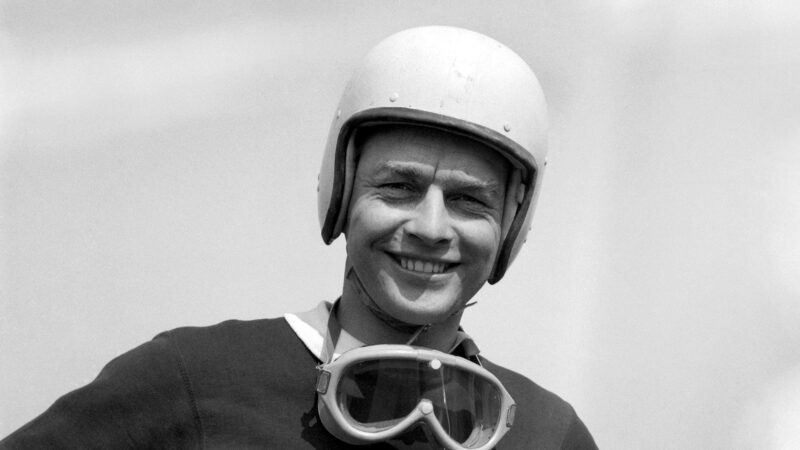
After great success with teams like Ecurie Ecosse, Flockhart died chasing a flight record.
Alamy
He feels the BRM tie was a hindrance: “He had to ask Sir Alfred [Owen] personally if he’d been offered a drive elsewhere, and if BRM had something coming up Owen would say no. It’s possible that people stopped asking.”
Others in the grand prix world regarded him as competent, but that’s all – “no problem on track” says one source. Perhaps adding a Sydney-London flight record to those Le Mans laurels would have gilded the image of this keen young Scot just a little.
